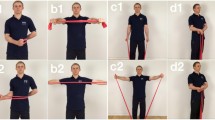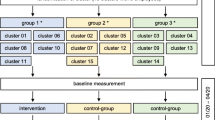Abstract
Introduction The goal of this study was to assess the effectiveness of a group-based interactive work style intervention in improving work style behavior. Methods Computer workers with neck and upper limb symptoms were randomised into the work style group (WS, N = 152), the work style and physical activity group (WSPA, N = 156), or the usual care group (N = 158). Both intervention groups received the same work style intervention but the WSPA group also received a lifestyle physical activity intervention. Participants from the intervention groups attended six group meetings which focused on behavioral change with regard to body posture and workstation adjustment, breaks, and coping with high work demands in order to reduce work stress. Stage of change, breaks and exercise behavior, and stress outcomes were assessed by questionnaire at baseline (T0) and after 6 (T1) and 12 months (T2). Body posture and workstation adjustment were assessed by observation and by questionnaire at T0, T1, and T2. Multilevel analyses were used to study differences in work style behavior between study groups. Results The work style intervention was effective in improving stage of change with regard to body posture, workstation adjustment, and the use of sufficient breaks during computer work. These findings were confirmed by higher self-reported use of breaks and exercise reminder software and less working hours without breaks. However, self-reported changes in body posture and workstation adjustment were less consistent. The work style intervention was ineffective in changing stress outcomes. Conclusion A group-based work style intervention seems to be effective in improving some elements of work style behavior. Future studies should investigate the effectiveness of work style interventions on all dimensions of the Feuerstein work style model.




Similar content being viewed by others
References
Heinrich J, Blatter BM. RSI-klachten in de Nederlandse beroepsbevolking. Trends, risicofactoren en verklaringen. Tijdschr Soc Geneeskd 2005;83:16–24.
De Kraker H, Blatter BM. Prevalentiecijfers van RSI-klachten en het voorkomen van risicofactoren in 15 Europese landen. Tijdschr Gezondheidsw 2005;83:8–15.
Blatter B, Houtman I, Van den Bossche S, Kraan K, Van den Heuvel S. Gezondheidsschade en kosten door RSI en psychosociale arbeidsbelasting. Den Haag: Ministerie van Sociale Zaken en Werkgelegenheid; 2006.
Feuerstein M. Workstyle: definition, empirical support, and implications for prevention, evaluation, and rehabilitation of occupational upper-extremity disorders. In: Moon SD, Sauter SL, editors. Beyond biomechanics: psychosocial aspects of musculoskeletal disorders in office work. Bristol, PA: Taylor and Francis Ltd., 1996; p. 177–206.
Feuerstein M, Nicholas RA, Huang GD, Haufler AJ, Pransky G, Robertson M. Workstyle: development of a measure of response to work in those with upper extremity pain. J Occup Rehabil 2005;15:87–104.
Haslam RA. Targeting ergonomics interventions—learning from health promotion. Appl Ergon 2002;33:241–9.
Nieuwenhuijsen ER. Health behavior change among office workers: an exploratory study to prevent repetitive strain injuries. Work 2004;23:215–24.
Velicer WF, Friedman RH, Fava JL, Gulliver SB, Keller S, Sun X, Ramelson H, Prochaska JO. Evaluating nicotine replacement therapy and stage-based therapies in a population-based effectiveness trial. J Consult Clin Psychol 2006;74:1162–72.
Riemsma RP, Pattenden J, Bridle C, Sowden AJ, Mather L, Watt IS, Walker A. Systematic review of the effectiveness of stage based interventions to promote smoking cessation. BMJ 2003;326:1175–7.
Dunn AL, Andersen AE, Jakicic JM: Lifestyle physical activity interventions. History, short- and long-term effects, and recommendations. Am J Prev Med 1998;15:398–412.
Adams J, White M: Why don’t stage-based activity promotion interventions work? Health Educ Res 2005;20:237–43.
Steptoe A, Doherty S, Rink E, Kerry S, Kendrick T, Hilton S. Behavioural counselling in general practice for the promotion of healthy behaviour among adults at increased risk of coronary heart disease: a randomised trial. BMJ 1999;319:943–8.
Delichatsios HK, Hunt MK, Lobb R, Emmons K, Gillman MW. EatSmart: efficacy of a multifaceted preventive nutrition intervention in clinical practice. Prev Med 2001;33:91–8.
Bernaards CM, Ariens GA, Knol DL, Hildebrandt VH. The effectiveness of a work style intervention and a lifestyle physical activity intervention on the recovery from neck and upper limb symptoms in computer workers. Pain 2007;132:142–53.
Bernaards CM, Ariens GA, Hildebrandt VH. The (cost-)effectiveness of a lifestyle physical activity intervention in addition to a work style intervention on the recovery from neck and upper limb symptoms in computer workers. BMC Musculoskelet Disord 2006;7:80.
Prochaska JO, DiClemente CC, Norcross JC: In Search of how people change: applications to addictive behaviors. Am Psychol 1992;47:1102–14.
Weinstein ND, Rothman AJ, Sutton SR. Stage theories of health behavior: conceptual and methodological issues. Health Psychol 1998;17:290–9.
Hanson EK, Schaufeli W, Vrijkotte T, Plomp NH, Godaert GL. The validity and reliability of the Dutch Effort-Reward Imbalance Questionnaire. J Occup Health Psychol 2000;5:142–55.
Van den Heuvel SG, Van der Beek AJ, Blatter BM, Bongers PM. Workstyle and overcommitment in relation to neck and upper limb symptoms. Int J Behav Med 2007;14:12–20.
Ostry AS, Kelly S, Demers PA, Mustard C, Herzman C. A comparison between the effort-reward imbalance and demand control models. BMC Public Health 2003;3:10.
Von Korff M, Ormel J, Keefe FJ, Dworkin SF. Grading the severity of chronic pain. Pain 1992;5:133–49.
McCullagh P. Regression models for ordinal data (with discussion). J Roy Statist Soc 1980;B42:109–42.
Spielholz P, Silverstein B, Morgan M, Checkoway H, Kaufman J. Comparison of self-reports, video observation and direct measurement methods for upper extremity musculoskeletal disorder physical risk factors. Ergonomics 2001;44;588–613.
Rizzo TH, Pelletier KR, Serxner S, Chikamoto Y. Reducing risk factors for cululative trauma disorders (CTDs): the impact of preventive ergonomic training on knowledge, intentions, and practices related to computer use. Am J Health Promot 1997;11:250–3.
Ketola R, Toivonen R, Häkkänen M, Luukkonen R, Takala E-P, Viikari-Juntura E. Effects of ergonomic intervention in work with video display units. Scand J Work Environ Health 2002;28;18–24.
Harrington SS, Walker B. The effects of ergonomics training on the knowledge, attitudes and practices of teleworkers. J Safety Res 2004;35:13–22.
Fenety A, Walker JM. Short-term effects of workstation exercises on musculoskeletal discomfort and postural changes in seated video display unit workers. Phys Ther 2002;82:578–89.
Peper E, Gibney KH, Wilson VE. Group training with healthy computing practices to prevent repetitive strain injury (RSI): a preliminary study. Appl Psychophysiol Biofeedback 2004;29:279–87.
Feuerstein M, Nicholas RA, Huang GD, Dimberg L, Ali D, Rogers H. Job stress management and ergonomic intervention for work-related upper extremity symptoms. Appl Ergon 2004;35:565–74.
Van den Heuvel SG, De Looze MP, Hildebrandt VH, The KH. Effects of software programs stimulating regular breaks and exercises on work-related neck and upper-limb disorders. Scand J Work Environ Health 2003;29:106–16.
Monsey M, Ioffe I, Beatini A, Lukey B, Santiago A, James AB. Increasing compliance with stretch breaks in computer users through reminder software. Work 2003;21(2):107–11.
Gillen M, Yen IH, Trupin L, Swig L, Rugulies R, Mullen K, Font A, Burian D, Ryan G, Janowitz I, Quinlan PA, Frank J, Blanc P. The association of socioeconomic status and psychosocial and physical workplace factors with musculoskeletal injury in hospital workers. Am J Ind Med 2007;50:245–60.
Brug J, Van Assema P, Kok G, Lenderink T, Glanz K. Self-rated dietary fat intake: associations with objective assessment of fate, psychosocial factors, and intention to change. J Nutr Educ 1994;26:218–23.
Ronda G, Van Assema P, Brug J. Stages of change, psychosocial factors and awareness of physical activity levels in the Netherlands. Health Promot Intern 2001;16:305–14.
Verheijden MW, Bakx JC, Delemarre IC, Wanders AJ, Van Woudenbergh NM, Bottema BJ, Van Weel C, Van Staveren WA. GP’s assessment of patients’ readiness to change diet, activity and smoking. Br J Gen Pract 2005;55:452–7.
Author information
Authors and Affiliations
Corresponding author
Rights and permissions
About this article
Cite this article
Bernaards, C.M., Ariëns, G.A.M., Simons, M. et al. Improving Work Style Behavior in Computer Workers with Neck and Upper Limb Symptoms. J Occup Rehabil 18, 87–101 (2008). https://doi.org/10.1007/s10926-007-9117-9
Received:
Accepted:
Published:
Issue Date:
DOI: https://doi.org/10.1007/s10926-007-9117-9




